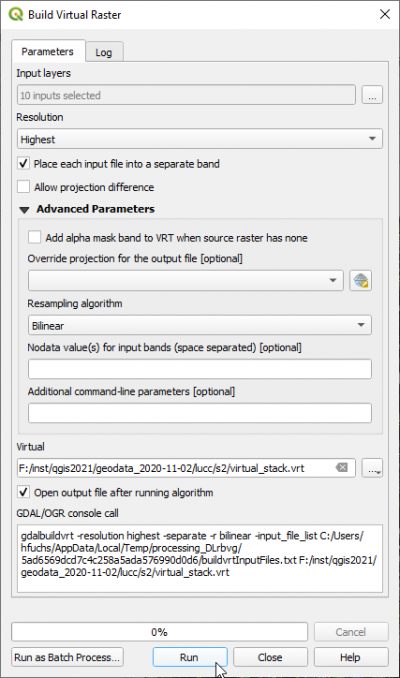Create stack
From AWF-Wiki
(Difference between revisions)
(→Create a multiband raster file (single bands to multiband)) |
(→Build a virtual stack) |
||
| Line 4: | Line 4: | ||
# Input files: Click {{button|text=Select}} and choose several single band raster files by holding Strg + left click. Take care on the order of the file selection: it determines the rank of bands in the resulting multiband file. | # Input files: Click {{button|text=Select}} and choose several single band raster files by holding Strg + left click. Take care on the order of the file selection: it determines the rank of bands in the resulting multiband file. | ||
# Output file: Click {{button|text=Select}} and choose a new file name. | # Output file: Click {{button|text=Select}} and choose a new file name. | ||
| − | # Click the checkbox -separate on (see screenshot below). | + | # Click the checkbox '''-separate''' on (see screenshot below). |
[[File:Qgis_virtual_raster.png|400px]] | [[File:Qgis_virtual_raster.png|400px]] | ||
# Click {{button|text=OK}} | # Click {{button|text=OK}} | ||
Revision as of 10:37, 25 October 2017
Build a virtual stack
A VRT (Virtual Dataset) is a list of links to input raster datasets. This has the advantage that no additional physical copy of the original files is necessary which saves storage place.
- Click Raster --> Miscellaneous --> Build Virtual Raster (Catalog).
- Input files: Click Select and choose several single band raster files by holding Strg + left click. Take care on the order of the file selection: it determines the rank of bands in the resulting multiband file.
- Output file: Click Select and choose a new file name.
- Click the checkbox -separate on (see screenshot below).
- Click OK
Create a multiband raster file (single bands to multiband)
A multiband file stores several single raster layers in one file.
